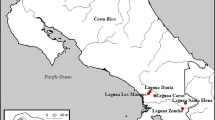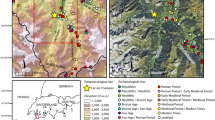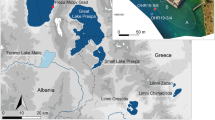Abstract
Pollen, plant macrofossil and charcoal analyses of sediments from two Alaskan lakes provide new data for inferring Lateglacial and Holocene environmental change. The records span the past 14,700 years at Lost Lake, 240 m a.s.l., central Alaska, north of the Alaska Range and 9600 years at Grizzly Lake, 720 m a.s.l., Copper River Plateau, south of the Alaska Range. Salix shrubs expanded in the herb tundra about 14,400 cal b.p., and Betula shrub tundra became established at ca. 13,200 cal b.p. Diminished Betula shrub cover in association with the increased abundance of herbaceous taxa occurred at 12,500–11,600 cal b.p., although the timing of these changes is not well constrained. Populus expanded at 11,200 cal b.p. and formed dense stands until 9600–9400 cal b.p. when Picea glauca forests or woodlands became established at both sites. The abundance of Alnus viridis increased markedly around 8500 cal b.p. at both sites, marking the development of alder shrub thickets around the lakes and on mountain slopes in these areas. Boreal forests dominated by Picea mariana became established around 7200 cal b.p. at Grizzly Lake and 5700 cal b.p. at Lost Lake. At Grizzly Lake, marked vegetational oscillations occurred within the past 8500 years; for example, A. viridis expanded at 2750 cal b.p. and 450 cal b.p. and declined at 150 cal b.p. Some of these oscillations coincide with large-scale climatic events, such as the Little Ice Age cooling (LIA), and they probably reflect vegetational sensitivity to climatic change at this high site. Microscopic charcoal at Lost Lake suggests that fire was important in the lateglacial birch tundra, probably because of severe moisture deficits of the regional climate and/or high abundance of fine fuels. On the basis of the Grizzly Lake microscopic charcoal record, regional fires were common between 8500 and 6800 cal b.p. and between 450 and 150 cal b.p. Around Grizzly Lake, the mean return intervals of local fires estimated from macroscopic charcoal were ∼386 years between 6800 and 5500 cal b.p. when Picea glauca dominated over P. mariana, ∼254 years between 5500 and 3900 cal b.p. when P. mariana was more abundant than P. glauca, and ∼200 years after 3900 cal b.p. in both P. glauca and P. mariana dominated forests. Correlation analysis of pollen and microscopic charcoal at Grizzly Lake reveals that increased fire activity led to the reductions of P. glauca, P. mariana, and tree Betula in association with the expansions of A. viridis, Epilobium, Lycopodium clavatum, and L. annotinum.








Similar content being viewed by others
References
Ager TA (1975) Late Quaternary environmental history of the Tanana Valley, Alaska. 54. Institute of Polar Studies, The Ohio State University, Columbus, Ohio
Anderson PM, Brubaker LB (1994) Vegetation history of northcentral Alaska: a mapped summary of late-quaternary pollen data. Quat Sci Rev 13:71–92
Anderson PM, Reanier RE, Brubaker LB (1990) A 14,000-Year Pollen Record from Sithylemenkat Lake, North-Central Alaska. Quat Res 33:400–404
Bahrenberg G, Giese E, Nipper J (1985) Statistische Methoden in der Geographie 1 - Univariate und bivariate Statistik. Teubner, Stuttgart
Bennett KD (1996) Determination of the number of zones in a biostratigraphical sequence. N Phytol 132:155–170
Bergeron Y, Archambault S (1993) Decreasing frequency of forest fires in the southern boreal zone of Québec and its relation to global warming since the end of the Little Ice Age. Holocene 3:255–259
Bigelow NH, Edwards ME (2001) A 14,000 yr paleoenvironmental record from Windmill Lake, Central Alaska: Lateglacial and Holocene vegetation in the Alaska Range. Quat Sci Rev 20:203–215
Birks HJB, Gordon AD (1985) Numerical methods in Quaternary pollen analysis. Academic Press, London
Björck S, Walker MJC, Cwynar LC, Johnsen S, Knudsen KL, Lowe JJ, Wohlfarth B (1998) An event stratigraphy for the Last Termination in the north Atlantic region based on the Greenland ice-core record: a proposal by the INTIMATE group. J Quat Sci 13:283–292
Bond G, Kromer B, Beer J, Muscheler R, Evans MN, Showers W, Hoffmann S, Lotti-Bond R, Hajdas I, Bonani G (2001) Persistent solar influence on north Atlantic climate during The Holocene. Science 294:2130–2136
Carcaillet C, Bergeron Y, Richard PJH, Frechette B, Gauthier S, Prairie YT (2001) Change of fire frequency in the eastern Canadian boreal forests during the Holocene: does vegetation composition or climate trigger the fire regime? J Ecol 89:930–946
Carlson LJ, Finney BP (2004) A 13 000-year history of vegetation and environmental change at Jan Lake, east-central Alaska. The Holocene 14:818–827
Clark JS, Royall PD, Chumbley C (1996) The role of fire during climate change in an eastern deciduous forest at Devil's Bathtub, New York. Ecology 77:2148–2166
Clegg BF, Tinner W, Gavin DG, Hu FS (2005) Morphological differentiation of Betula (birch) pollen in northwest North America and its palaeoecological application. The Holocene 15:229–237
Dansgaard W, Johnson SJ, Clausen HB, Dahl-Jensen D, Gundestrup NS, Hammer CU, Hvidberg CS, Steffensen JP, Sveinbjörnsdottir AE, Jouzel J, Bond G (1993) Evidence for general instability of past climate from a 250-kyr ice-core record. Nature 364:218–220
Earle CJ, Brubaker LB, Anderson PM (1996) Charcoal in northcentral Alaskan lake sediments: relationships to fire and late-Quaternary vegetation history. Rev Palaeobot Palynol 92:83–95
Engstrom DR, Hansen BCS, Wright HE (1990) A possible Younger Dryas record in southeastern Alaska. Science 250:1383–1385
Finsinger W, Tinner W (2005) Minimum count sums for charcoal-concentration estimates in pollen slides: accuracy and potential errors. The Holocene 15:293–297
Flannigan M, Bergeron Y, Engelmark O, Wotton M (1998) Future wildfire in the northern forests: less than global warming would suggest. J Veg Sci 9:469–476
Flannigan M, Campbell I, Wotton M, Carcaillet C, Richard P, Bergeron Y (2001) Future fire in Canada's boreal forest: paleoecology results and general circulation model – regional climate model simulations. Can J For Res – Revue Canadienne de Recherche Forestière 31:854–864
FNA (2005) http://www.fna.org/FNA/
Forester RM, Delorme LD, Ager TA (1989) A lacustrine record of late Holocene climate change from south-central Alaska. Geophys Monogr 55:33–40
Gäggeler H, von Gunten HR, Nyffeler U (1976) Determination of 210Pb in lake sediments and in air samples by direct gamma-ray measurement. Earth Planet Sci Lett 33:119–121
van Geel B, van der Plicht J, Kilian MR, Klaver ER, Kouwenberg JHM, Renssen H, Reynaud-Farrera I, Waterbolk HT (1998) The sharp rise of Delta C-14 ca 800 cal B.C.: Possible causes, related climatic teleconnections and the impact on human environments. Radiocarbon 40:1163–1164
von Grafenstein U, Erlenkeuser H, Brauer A, Jouzel J, Johnsen SJ (1999) A Mid-European decadal isotope-climate record from 15,500 to 5000 years b.p. Science 284:1654–1557
Grootes PM, Stuiver M, White JWC, Johnsen S, Jouzel J (1993) Comparison of oxygen isotope records from the GISP2 and GRIP Greenland ice cores. Nature 366:552–554
Heiri O, Millet L (2005) Reconstruction of Late Glacial summer temperatures from chironomid assemblages in Lac Lautrey (Jura, France). J Quat Sci 20:33–44
Heiri O, Tinner W, Lotter AF (2004) Evidence for cooler European summers during periods of changing meltwater flux to the North Atlantic. Proc Natl Acad Sci USA 101:15285–15288
Higuera PE, Sprugel DG, Brubaker LB (2005) Reconstructing fire regimes with charcoal from small hollows: a calibration with tree-ring records of fire. The Holocene 15:238–251
Hu FS, Shemesh A (2003) A biogenic-silica delta O-18 record of climatic change during the last glacial-interglacial transition in southwestern Alaska. Quat Res 59:379–385
Hu FS, Brubaker LB, Anderson PM (1993) A 12000 year record of vegetation change and soil development from Wien Lake, central Alaska. Can J Bot – Revue Canadienne de Botanique 71:1133–1142
Hu FS, Brubaker LB, Anderson PM (1995) Postglacial vegetation and climate-change in the northern Bristol Bay region, southwestern Alaska. Quat Res 43:382–392
Hu FS, Brubaker LB, Gavin DG, Higuera PE, Lynch JA, Rupp TS, Tinner W (in press) How climate and vegetation influence the fire regime of the Alaskan boreal biome: The Holocene perspective. Mitigation and Adaptation Strategies for Global Change
Hu FS, Ito E, Brown TA, Curry BB, Engstrom DR (2001) Pronounced climatic variations in Alaska during the last two millennia. Proc Natl Acad Sci USA 98:10552–10556
Hu FS, Ito E, Brubaker LB, Anderson PM (1998) Ostracode geochemical record of Holocene climatic change and implications for vegetational response in the northwestern Alaska range. Quat Res 49:86–95
Hu FS, Kaufman D, Yoneji S, Nelson D, Shemesh A, Huang Y, Tian J, Bond G, Clegg B, Brown T (2003) Cyclic variation and solar forcing of Holocene climate in the Alaskan subarctic. Science 301:1890–1893
Hu FS, Lee BY, Kaufman DS, Yoneji S, Nelson DM, Henne PD (2002) Response of tundra ecosystem in southwestern Alaska to Younger-Dryas climatic oscillation. Global Change Biol 8:1156–1163
Hultén E (1968) Flora of Alaska and neighboring territories. Stanford University Press, Stanford, CA
Kaufman DS, Ager TA, Anderson NJ, Anderson PM, Andrews JT, Bartlein PJ, Brubaker LB, Coats LL, Cwynar LC, Duvall ML, Dyke AS, Edwards ME, Eisner WR, Gajewski K, Geirsdottir A, Hu FS, Jennings AE, Kaplan MR, Kerwin MN, Lozhkin AV, MacDonald GM, Miller GH, Mock CJ, Oswald WW, Otto-Bliesner BL, Porinchu DF, Ruhland K, Smol JP, Steig EJ, Wolfe BB (2004) Holocene thermal maximum in the western Arctic (0–180 degrees W). Quat Sci Rev 23:529–560
Lévesque PEM, Dinel H, Larouche A (1988) Guide to the identification of plant macrofossils in Canadian peatlands. Canadian Government Publishing Centre, Ottawa
Litt T, Brauer A, Goslar T, Merkt J, Balaga K, Müller H, Ralska-Jasiewiczowa M, Stebich M, Negendank JFW (2001) Correlation and synchronisation of Lateglacial continental sequences in northern central Europe based on annually laminated lacustrine sediments. Quat Sci Rev 20:1233–1249
Litt T, Schmincke HU, Kromer B (2003) Environmental response to climatic and volcanic events in central Europe during the Weichselian Lateglacial. Quat Sci Rev 22:7–32
Lowe JJ, Hoek WZ (2001) Inter-regional correlation of palaeoclimatic records for the Last Glacial-Interglacial Transition: a protocol for improved precision recommended by the INTIMATE project group. Quat Sci Rev 20:1175–1187
Lotter AF (1999) Late-glacial and Holocene vegetation history and dynamics as evidenced by pollen and plant macrofossil analyses in annually laminated sediments from Soppensee (central Switzerland). Veget Hist Archaeobot 8:165–184
Lynch JA, Clark JS, Bigelow NH, Edwards ME, Finney BP (2002) Geographic and temporal variations in fire history in boreal ecosystems of Alaska. J Geophys Res-Atmos 107:8152, doi:10.1029/2001JD000332
Lynch JA, Hollis JL, Hu FS (2004a) Climatic and landscape controls of the boreal forest fire regime: Holocene records from Alaska. J Ecol 92:477–489
Lynch JA, Clark JS, Stocks BJ (2004b). Charcoal production, dispersal, and deposition from the Fort Providence experimental fire: interpreting fire regimes from charcoal records in boreal forests. Can J For Res – Revue Canadienne de Recherche Forestière 34:1642–1656
Moore PD, Webb JA, Collinson ME (1991) Pollen analysis, (2nd edn). Blackwell, London
Oswald WW, Anderson PM, Brown TA, Brubaker LB, Hu FS, Lozhkin AV, Tinner W, Kaltenrieder P (2005) Effects of sample size and type on radiocarbon dating of arctic and subarctic lake sediments. The Holocene 15:758–767
Peteet DM, Mann DH (1994) Late-Glacial vegetational, tephra, and climatic history of southwestern Kodiak Island, Alaska. Ecoscience 1:255–267
Punt W, Blackmore S, Hoen PP, Stafford PJ (2005) The northwest European pollen flora - Volume VIII. In: Hoen P (ed) Webedition, http://www.bio.uu.nl/∼palaeo//Research2/NEPF/volume8.htm
Ramsey CB (2001) Development of the radiocarbon calibration program. Radiocarbon 43:355–363
Reimer PJ, Baillie MGL, Bard E, Bayliss A, Beck JW, Bertrand CJH, Blackwell PG, Buck CE, Burr GS, Cutler KB, Damon PE, Edwards RL, Fairbanks RG, Friedrich M, Guilderson TP, Hogg AG, Hughen KA, Kromer B, McCormac FG, Manning SW, Ramsey CB, Reimer RW, Remmele S, Southon JR, Stuiver M, Talamo S, Taylor FW, van der Plicht J, Weyhenmeyer CE (2004) IntCal04 Terrestrial radiocarbon age calibration, 26–0 ka BP. Radiocarbon 46:1029–1058
Rupp TS, Starfield AM, Chapin FS, Duffy P (2002) Modeling the impact of black spruce on the fire regime of Alaskan boreal forest. Clim Change 55:213–233
Stockmarr J (1971) Tablets with spores used in absolute pollen analysis. Pollen et Spores 13:615–621
Stuiver M, Reimer PJ (1993) Extended 14C data base and revised CALIB 3.014C age calibration program. Radiocarbon 35:215–230
Tinner W, Conedera M, Ammann B, Gäggeler HW, Gedye S, Jones R, Sägesser B (1998) Pollen and charcoal in lake sediments compared with historically documented forest fires in southern Switzerland since AD 1920. The Holocene 8:31–42
Tinner W, Hu FS (2003) Size parameters, size-class distribution and area-number relationship of microscopic charcoal: relevance for fire reconstruction. The Holocene 13:499–505
Viereck LA, Little EL (1994) Alaska trees and shrubs. University of Alaska, Fairbanks
Whitlock C, Larsen C (2001) Charcoal as a fire proxy. In: Smol JP, Birks HJB, Last WM (eds) Tracking environmental change using lake sediments. Terrestrial, algal, and siliceous indicators. Kluwer, Dordrecht, pp. 75–97
Wright HE, Mann DH, Glaser PH (1984) Piston corers for peat and lake sediments. Ecology 65:657–659
WorldClimate (2005) http://www.worldclimate.com/
Acknowledgments
We thank B. Ammann, B. Curry, J. Hollis, W. Tanner, and H.E. Wright Jr. for their great help during the coring trips. R. Shaw, S. McMillan, and F. Oberli are gratefully acknowledged for laboratory work and B. Clegg, B.Y. Lee as well as J. van Leeuwen for assistance with pollen determination. We are deeply indebted to W. Oswald, T. Brown, G. Possnert, and M. Söderman for radiocarbon dating and to the Wrangell National Park (Alaska) for permission to core in the year 2000. This study was financed by the Swiss and US National Science Foundations. We thank J. Carrión, B. Vannière, and W.O. van der Knaap for useful suggestions on the manuscript.
Dedication
This study is dedicated to Brigitta Ammann. She bore this and many other projects by her steady support, encouragement, and innovative ideas. One of her most characteristic scientific attitudes is to address new questions in new landscapes with a broad set of palaeoecological tools. For instance she initiated W.T. to investigate palaeofire issues in the Alps in 1993. In 1998 she supported the idea of F.S.H. and W.T. to investigate the fire history of the Copper River Basin by offering a post-doctoral position to W.T. in Bern. Among other things this led to a Swiss NSF post-doc fellowship for W.T. to visit F.S.H. in Urbana-Champaign. This visit in 1999/2000 allowed the start of the Alaskan investigations presented in this study. During the following years Brigitta - who had joined the expedition to Alaska in 1999 - always supported our Alaskan investigations, for instance by encouraging students (R.B. and B.S.) to take over master theses on the Grizzly and Lost Lake cores or by offering laboratory assistance and financing radiocarbon dates. Thus it is difficult to express how deeply indebted we are to Brigitta for her generous, tolerant and congenial attitude during all these years!
Author information
Authors and Affiliations
Corresponding author
Additional information
Communicated by Pim van der Knaap
Rights and permissions
About this article
Cite this article
Tinner, W., Hu, F.S., Beer, R. et al. Postglacial vegetational and fire history: pollen, plant macrofossil and charcoal records from two Alaskan lakes. Veget Hist Archaeobot 15, 279–293 (2006). https://doi.org/10.1007/s00334-006-0052-z
Received:
Accepted:
Published:
Issue Date:
DOI: https://doi.org/10.1007/s00334-006-0052-z




